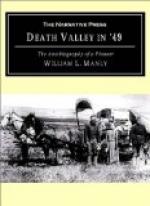At one point on this route we came into a long narrow valley, well covered with sage brush, and before we had gone very far we discovered that this was a great place for long eared rabbits, we would call them Jack Rabbits now. Every one who had a gun put it into service on this occasion, and there was much popping and shooting on every side. Great clouds of smoke rolled up as the hunters advanced and the rabbits ran in every direction to get away. Many ran right among the horses, and under the feet of the cattle and under the wagons, so that the teamsters even killed some with a whip. At the end of the valley we went into camp, and on counting up the game found we had over 500, or about one for every person in camp. This gave us a feast of fresh meat not often found.
It was on this trip that one of Mr. Bennett’s ox drivers was taken with a serious bowel difficulty, and for many days we thought he would die, but he eventually recovered. His name was Silas Helmer.
It was really a serious moment when the front of the train reached the Smith trail. Team after team turned to the right while now and then one would keep straight ahead as was at first intended. Capt. Hunt came over to the larger party after the division was made, and wished them all a hearty farewell and a pleasant happy journey. My friend Bennett whose fortune I shared was among the seceders who followed the Smith party. This point, when our paths diverged was very near the place afterward made notorious as Mountain Meadows, where the famous massacre took place under the direction of the Mormon generals. Our route from here up to the mountain was a very pleasant one, steadily up grade, over rolling hills, with wood, water and grass in plenty. We came at last to what seemed the summit of a great mountain, about three days journey on the new trail. Juniper trees grew about in bunches, and my experience with this timber taught me that we were on elevated ground.
Immediately in front of us was a canon, impassible for wagons, and down into this the trail descended. Men could go, horses and mules, perhaps, but wagons could no longer follow that trail, and we proposed to camp while explorers were sent out to search a pass across this steep and rocky canon. Wood and bunch grass were plenty, but water was a long way down the trail and had to be packed up to the camp. Two days passed, and the parties sent out began to come in, all reporting no way to go farther with the wagons. Some said the trail on the west side of the canon could be ascended on foot by both men and mules, but that it would take years to make it fit for wheels.
The enthusiasm about the Smith cut-off had begun to die and now the talk began of going back to follow Hunt. On the third morning a lone traveler with a small wagon and one yoke of oxen, died. He seemed to be on this journey to seek to regain his health. He was from Kentucky, but I have forgotten his name. Some were very active about his wagon and, some thought too much attention was paid to a stranger. He was decently buried by the men of the company.




